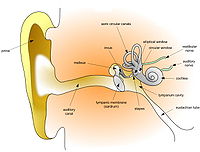
Photo from wikipedia
&NA; We investigated speech recognition in noise in subjects with mild to profound levels of unilateral hearing loss. Thirty‐five adults were evaluated using an adaptive signal‐to‐noise ratio (SNR50) sentence recognition… Click to show full abstract
&NA; We investigated speech recognition in noise in subjects with mild to profound levels of unilateral hearing loss. Thirty‐five adults were evaluated using an adaptive signal‐to‐noise ratio (SNR50) sentence recognition threshold test in three spatial configurations. The results revealed a significant correlation between pure‐tone average audiometric thresholds in the poorer ear and SNR thresholds in the two conditions where speech and noise were spatially separated: dichotic – with speech presented to the poorer ear and reverse dichotic – with speech presented to the better ear. This first result suggested that standard pure‐tone air‐conduction thresholds can be a reliable predictor of speech recognition in noise for binaural conditions. However, a subgroup of 14 subjects was found to have poorer‐than‐expected speech recognition scores, especially in the reverse dichotic listening condition. In this subgroup 9 subjects had been diagnosed with vestibular schwannoma at stage III or IV likely affecting the lower brainstem function. These subjects showed SNR thresholds in the reverse dichotic condition on average 4 dB poorer (higher) than for the other 21 normally‐performing subjects. For the 7 of 9 subjects whose vestibular schwannoma was removed, the deficit was no longer apparent on average 5 months following the surgical procedure. These results suggest that following unilateral hearing loss the capacity to use monaural spectral information is supported by the lower brainstem. HighlightsSubjects with mild to total unilateral hearing loss were evaluated with both the Matrix test and clinical audiometries.Pure‐tone air conduction can be a reliable predictor for binaural hearing evaluation.Vestibular schwannoma stage III or IV may affect the lower brainstem structure and creates binaural hearing distortions.A surgical schwannoma removal may allowed monaural spectral remapping.
Journal Title: Neuropsychologia
Year Published: 2017
Link to full text (if available)
Share on Social Media: Sign Up to like & get
recommendations!